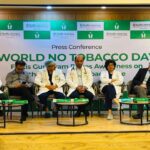- ISA Hosts ‘Webinar ‘Know Stroke-Beat Stroke’
- The one-hour webinar aims to spotlight brain stroke, India’s leading cause of paralysis, and promote awareness, early detection, and intervention
India
healthysoch
New Delhi, May 31, 2025:
On the occasion of Brain Stroke Awareness Month and World Thrombectomy Day, the Indian Stroke Association (ISA), in association with Rotary Clubs of Guntur and the Indian Red Cross Society, conducted a one-hour live webinar, Know Stroke-Beat Stroke, on 15th May 2025. This educational webinar aimed to spread the awareness of stroke, its effects, treatments available, the golden hour time is a brain concept, and the latest advances, including Mechanical Thrombectomy. With more than 490 registrations from India, USA, and Australia, it was an interesting interactive session.
With the alarming rise in stroke cases in India, this initiative is designed to empower the general public and healthcare professionals with essential knowledge about stroke causes, modifiable risk factors, early warning signs, and treatment options. Dr. P. Vijaya, President of ISA, and Dr.Vikam Huded, President Elect, ISA, Dr. Arvind Sharma, Secretary of ISA, Dr. Dileep R. Yavagal, Interventional Neurologist from Miami, USA were the esteemed speakers while panelists were Dr. Shripal Shah, Dr. Trilochan Srivastava, Dr. Salil Uppal, Dr. Anand Alurkar, Dr. Nirmal Surya, Dr. R. Lakshmi Narasimhan, Dr. Amit Kulkarni, Dr. Jayanta Roy, Dr. Monika Singla, and Dr. Pawan Kumar Ojha.
Brain stroke, commonly known as paralysis, is a leading cause of death and disability worldwide. “One in four will get a stroke during a lifetime. On average, at least 18 lakh individuals are affected by stroke every year. Alarmingly, nearly one-fourth of these cases occur in people below 40-45, highlighting a serious concern about the loss of productive years and the resulting financial, economic, and social burden on families and the nation. Up to 80% of strokes are preventable, and early treatment can make a big difference. Recognize stroke signs using BEFAST -Balance, Eyes, Face, Arms, Speech, and Time to reach help. Time lost is brain lost. There are many effective treatments, but they are all time-sensitive. Stroke treatment involves two key approaches. The first is administering clot-busting drugs within four and a half hours of symptom onset. The second is mechanical thrombectomy, a highly effective treatment used in patients with severe strokes caused by large vessel occlusion. This procedure can be performed up to 24 hours after stroke onset and has been available for the past ten years. However, access to this treatment remains limited. We are actively working towards making mechanical thrombectomy equitably accessible, ensuring that all patients in need can benefit from this life-saving intervention,” said Dr. P. Vijaya, President of the Indian Stroke Association (ISA).
Dr. Arvind Sharma, Secretary, Indian Stroke Association, underscored, “Timely action is crucial for stroke. IV thrombolysis, that is, a clot-busting drug, can be given within the golden period of four and a half hours. If the patient is brought within four and a half hours and the CT scan rules out hemorrhage, we can use a clot-buster drug so that most of the patients can recover to a great extent without any disability. This webinar serves as an eye-opener not just for the general public but also for healthcare providers who may encounter stroke cases in early stages. By spreading timely knowledge and intervention strategies, we hope to improve recovery outcomes and reduce stroke-related disability across the country.”
Prof. Dilip Yavagal, A Global Pioneer in Advancing Stroke Care Equity & Founder Of The Mission Thrombectomy Programme and who is working for equitable care across the globe, said, “I am honored to be part of this meaningful initiative aimed at raising global awareness about stroke. Despite being recognized for over a decade as a highly effective treatment, access to mechanical thrombectomy (MT) remains extremely limited, with a global median access rate of only 2.79% and a staggering 460-fold disparity between the lowest and highest access regions. Yet, the cost of implementing a stroke thrombectomy care system is relatively modest, averaging USD 11.8 million per one million population.
MT is also proven to be highly cost-effective across all GDP levels. Evidence shows that establishing a National Stroke Policy can significantly improve stroke therapy outcomes and reduce stroke-related deaths. The 2023 Lancet Commission Report highlights the need for substantial global investment and pragmatic policy measures to alleviate the worldwide impact of stroke and help achieve SDG goal 3.4. Currently, we are in discussions to include Mechanical Thrombectomy under the Ayushman Bharat Yojana, making it more accessible for stroke patients.”







